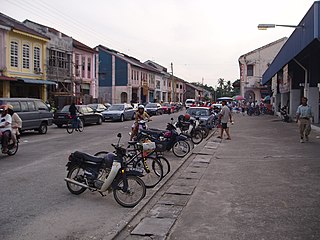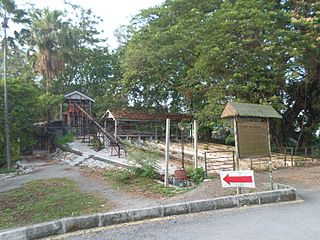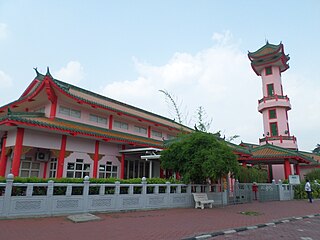
Perak is a state of Malaysia on the west coast of the Malay Peninsula. Perak has land borders with the Malaysian states of Kedah to the north, Penang to the northwest, Kelantan and Pahang to the east, and Selangor to the south. Thailand's Yala and Narathiwat provinces both lie to the northeast. Perak's capital city, Ipoh, was known historically for its tin-mining activities until the price of the metal dropped, severely affecting the state's economy. The royal capital remains Kuala Kangsar, where the palace of the Sultan of Perak is located. As of 2018, the state's population was 2,500,000. Perak has diverse tropical rainforests and an equatorial climate. The state's mountain ranges belong to the Titiwangsa Mountains, which is part of the larger Tenasserim Hills system that connects Myanmar, Thailand and Malaysia.

Ipoh is the capital city of the Malaysian state of Perak. Located by the Kinta River, it is nearly 200 km (120 mi) north of Kuala Lumpur and 150 km (93 mi) southeast of George Town in neighbouring Penang. As of the 2020 census Ipoh had a population of 759,952, making it the eighth-largest city in Malaysia by population.

Teronoh is a small tin-mining town in Kinta District, Perak, Malaysia.

Kellie's Castle is a castle located in Batu Gajah, Kinta District, Perak, Malaysia. The unfinished, ruined mansion, was built by a Scottish planter named William Kellie-Smith. According to differing accounts, it was either a gift for his wife or a home for his son. Kellie's Castle is situated beside the Raya River, which is a small creek to the Kinta River.

The Kinta District is a district in Perak, Malaysia. It contains the state capital Ipoh. Kinta is the most populated district in Perak and also the seventh most populated district in Malaysia. Kinta houses Ipoh, Perak's largest city and state capital while Batu Gajah is a seat in Kinta district.

Kinta River is a river in Perak, Malaysia. It gets its name from the Kinta Valley, which surrounds Ipoh, the capital of Perak. Ipoh sits along this river. There are many limestone hills in the area surrounding the river, and there used to be many tin mines. The supposedly largest tin field in the world was discovered in 1876 in the Kinta Valley. The river was also well known for its wide variety of freshwater fish. The fisheries department reported a greater abundance of fish from the Intake Dam to Tasek, and from a secluded fish pool, 0.75 miles (1.21 km) down from Tanjung Rambutan. Fishing in this area used to be a major local activity until the fisheries gradually closed down.

Jean-Jacques de Morgan was a French mining engineer, geologist, and archaeologist. He was the director of antiquities in Egypt during the 19th century, and excavated in Memphis and Dashur, providing many drawings of many Egyptian pyramids. He also worked at Stonehenge, and Persepolis, and many other sites.

The Perak Museum is a public museum located at the junction of Jalan Muzium and Jalan Taming Sari in Taiping, Perak, Malaysia. It is the oldest museum in Malaysia and highlights the history of the state.

The Kinta Valley is a conurbation in central Perak, Malaysia, surrounding and including the state capital Ipoh. Historically the Kinta Valley was very rich in tin, and their mines have been among the most productive in the world. The valley is formed by the Kinta River, a tributary of the Perak River, which flows between the Titiwangsa Mountains and the Kledang Range.

The Beruas Museum is a museum in Beruas, Manjung District, Perak, Malaysia. The goal of the Beruas Museum is to collect history and artifacts related to the lost kingdom of Gangga Negara and Beruas.

Han Chin Pet Soo (闲真别墅) is Malaysia's first Hakka tin mining museum and is the number one attraction in Ipoh on TripAdvisor. Located on the edge of Ipoh's Old Town, close to the Kinta River, it is in walking distance of the well-known Panglima Lane. It is managed by Ipoh World Sdn. Bhd.

The Birch Memorial Clock Tower is a clock tower in Ipoh, Kinta District, Perak, Malaysia.

The Lost World of Tambun (LWOT) is a theme park and hotel in Sunway City Ipoh, Tambun, Kinta District, Perak, Malaysia. Managed by the Sunway Group, the 40-acre park opened on 11 November 2004, and is officiated by Sultan Azlan Shah.

The Palong Tin Museum is a museum in Ipoh, Kinta District, Perak, Malaysia.

Mining is one of the main industries in Malaysia. Malaysia produces aggregate, bauxite, clay, coal, copper, feldspar, gold, gravel, ilmenite, iron ore, kaolin, limestone, mica, monazite, sand, silica sand, struverite and tin.

The Perak State Herb Park is a park in Batu Gajah, Kinta District, Perak, Malaysia.

The Darul Ridzuan Museum is a museum in Ipoh, Kinta District, Perak, Malaysia.

Tambun rock art, is a series of Neolithic-era cave paintings at the Gunung Panjang limestone hill in Tambun, on the outskirts of Ipoh, Perak, Malaysia. The paintings were discovered on a rocky overhang in 1959 by 2/Lt R. L. Rawlings of the 2nd Battalion, 6th Queen Elizabeth's Own Gurkha Rifles. Popularly known as the "Tambun Cave Paintings", the paintings could have been made by the ancestors of the Orang Asli and had spiritual importance. This site should not be confused with Gunung Tambun, another limestone hill that is found several kilometres to the north of Gunung Panjang.

The Muhammadiah Mosque is a mosque in Ipoh, Kinta District, Perak, Malaysia.




















